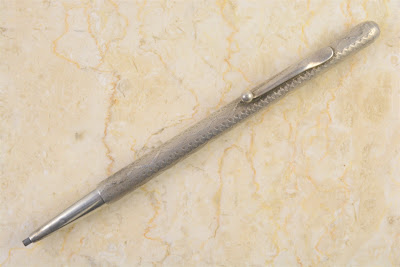This article has been edited and included in The Leadhead's Pencil Blog Volume 5; copies are available print on demand through Amazon here, and I offer an ebook version in pdf format at the Legendary Lead Company here.
If you don't want the book but you enjoy this article, please consider supporting the Blog project here.
The mechanism appears to be the Mabie 1853 patent, with a nose that advances by twisting the back half of the pencil, but this one is much later, which I know from the hallmark at the top of the pencil:
That big H, with a W above the crossbar and an S below it, is a Hicks mark I’m asked about frequently. I can now tell you, with the assistance of American Writing Instrument Trademarks 1870-1953, that it is a great help in dating the pencil:
William S. Hicks’ Sons registered the mark in 1914, and in the application, Edward D. Hicks claimed that it was first used by the firm on November 1, 1912; so much as we like to refer to pencils such as this one as “Victorians,” it is Victorian in style only . . . that mark reveals that it was made after Victoria died in 1901, and in fact after her successor died, as well . . . “Georgian” woudl be a more historically accurate name for one like this.
The ringtop looks freakishly large on this one, which gives you some idea how small this one is:
Here it is shown alongside that massive multicolor Hicks/Cartier I wrote about last year (see http://leadheadpencils.blogspot.com/2016/10/hicks-family-oddities-ii.html).
There was one other W.S. Hicks pencil that turned up while I was reorganizing things that I wanted to show you:
This one also has the post-1912 mark on it, which isn’t at all surprising on this one (the mechanism, we know, was patented in 1918 – see http://leadheadpencils.blogspot.com/2016/10/hicks-family-oddities-i.html).
What’s interesting about this one is the machine work that went into the barrel . . . I can’t tell if this was pressed, stamped or acid etched. I don’t think it’s machine chased or engraved:







1 comment:
No question, it's line chased.
Post a Comment